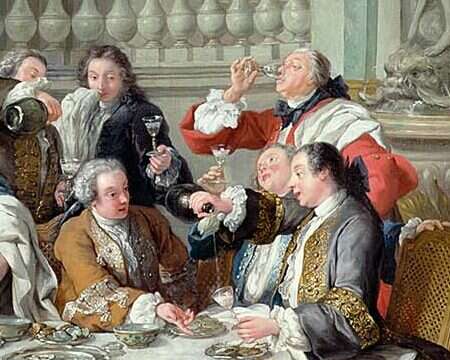
Tom Stevenson brings out the fascinating details in one of his favorite paintings, Le Déjeuner d’Huîtres or The Oyster Luncheon by Jean François de Troy (1735), which among other reasons is notable for featuring the first sparkling Champagne captured in art.
It could be said that Jean François de Troy’s Le Déjeuner d’ Huîtres or The Oyster Luncheon (1735) is more famous in the world of wine than it is in the world of art, since it represents the first sparkling Champagne to be captured in paint, the photography of its time.
Not that this is meant to infer that de Troy (1679–1752) was a slouch as an artist. He was very successful and had been famous in his own lifetime, which is more than some grand masters could claim. He was one of France’s leading historical painters and also painted frescos, including one in the north aisle of the ancient basilica of Santi Bonifacio e Alessio in Rome. Moreover, this particular painting was commissioned by none other than Louis XV, who wanted something that would express a joie de vivre for a new private dining room in his petits appartements at the Palace of Versailles, for which he paid de Troy the sum of 2,400 livres (about $28,000 by today’s value) according to the king’s fastidiously kept accounts.
At least one author has suggested that it was commissioned to be hung in the room where Louis XV entertained Madame de Pompadour, but he did not meet her until 1744, the year before she became his maîtresse en chef (official chief mistress).
Le Déjeuner d’Huîtres: Compelling viewing

Le Déjeuner d’Huîtres is some 6ft x 4ft (1.8 x 1.2m) and currently hangs in the Musée Condé at the majestic Château de Chantilly, just north of Paris. It is compelling viewing, so if you are visiting the capital or make a dog-leg diversion when driving from the UK to Champagne, it is well worth the €17 entry fee. Château de Chantilly is also the most spectacular race course in the world and home to two of the most prestigious races in the France Galop (the Prix du Jockey-Club and the Prix de Diane Longines).
Jean François de Troy pioneered the tableaux de mode, a genre that diligently depicts the contemporary fashions and manners of the higher social classes in 18th-century France. In Le Déjeuner d’Huîtres we see the diners, recently returned from a hunt, eating oysters and drinking Champagne in a sumptuously decorated room. Oysters were very fashionable among the elite at that time, and although medical books of the time alluded to the belief that had aphrodisiac properties, the diners are exclusively male.
The round table is covered by a rectangular table cloth, upon which we can see the bread, butter, salt, pepper, and wild garlic, the traditional accompaniments to oysters in those days. There are young servants with a towel at their waist, shucking the oysters for the guests. Full oysters are arranged on the table in silver platters, while empty shells litter the floor. Older servants open and pour the Champagne into stemmed glasses, which when not in use are overturned in painted porcelain bowls. Two bottles of unopened Champagne are chilling in ice and water in the lead-lined compartments of a small cellarette in front of the table.
Finally, the fresco reproduced at the top of Le Déjeuner d’Huîtres is a pastiche of his own work, Zéphyr et Flor (c. 1725–1726), an audacious example of self-advertisement.
Stevenson on Le Déjeuner d’Huîtres: Eight observations
I always find something different every time I look at this painting.
Here are a few of my current thoughts:
1. The mushroom-shaped cork is clearly visible, as is the string ficelage that held the cork in the bottle. This is the equivalent of the first photo of a Champagne cork in flight!

2. This gentleman has just cut the string to release the cork using the knife held in his right hand. He has his thumb over the mouth of the bottle to prevent the Champagne from gushing out. Note the typically 18th-century shape of the bottle with its distinct punt. Who is the producer? It can only be one of three: Ruinart (1729), Chanoine Frères (1730), Forest Fourneaux (Taittinger; 1734). Based on how the present-day bottles look, my money is on Ruinart.

3. Pouring from a height to increase the foam is an indication that despite the cork flying high, the mousse was relatively weak in France in 1735. The glass is a regular wine glass, not a coupe or a flute. Note the way it is being held by both the diner and the server, clearly indicating this is not the invention of modern-day wine geeks.

4. Again pouring from a height. The gentleman behind is obviously appreciating the mousse “as it puns in the glass.”

5. None of the glasses in the painting are standing up, they are all either in hand or, as illustrated here, resting in bowls. The bowls were required for rinsing any glasses from sediment that would still have been in the bottle at this juncture.
6. More examples of geeky-held glasses.

7. Sealed bottles of Champagne chilling in ice and water. The ice would come from the host’s own ice house, which would be filled up every winter with tons of ice transported from frozen lakes (the ice destined for the great ice-houses of Versailles came, for example, from Switzerland).

8. Jean François de Troy was an artist and draughtsman who was so renowned for his accuracy and detail that we can identify Calais as the source of the oysters being shucked from the size of the shells and color of the flesh, yet the nobleman here, widely regarded by art historians as the host, is oddly proportioned. From the angle at which he is leaning, we can imagine where the femur starts, which makes his upper leg improbably long. The humerus in his right arm is also suspiciously long, while his left arm is far from convincing in a way that has nothing to do with the cut of its sleeve, which is deliberately short to accommodate the ruffled cuffs. Were there originally two people sat here? Did one have to be cut and merged into one leaning figure to accommodate the knife hand of the bottle opener, which is so intrinsic to the composition? Or was the painting badly damaged and poorly repainted?

After Le Déjeuner d’Huîtres was delivered to Versailles, highly skilled craftsmen carefully integrated it with the wall panelling, but it had to be removed in 1768, when the petits appartements were converted into offices and kitchens. According to the Musée Condé, the canvas had at one point been given a more regular shape, and in 2000 it received a complete clean, which supposedly included the removal of repainted areas, yet the host of the lunch remains oddly proportioned. It seems to me that these clues are likely to lead to a more rational explanation of this mystery than the possibility of a meticulous draughtsman like de Troy painting such a malformed figure and being handsomely paid for it by the king of France.






